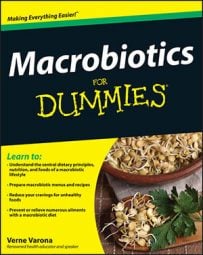Here are some basic guidelines for choosing foods that fit within your macrobiotic diet plan. This dietary model outlines principle foods, secondary foods, and pleasure foods.
Principle foods
Whole grains: Approximately 25 to 30 percent by volume for the amount of food consumed for one day
Grain products: Approximately 5 percent per day (as in 1 to 2 slices of bread or 1 to 2 servings of pasta)
Vegetables: Approximately 35 percent of the day’s total percentage of food from greens, roots, and ground varieties
Beans: Approximately 5 to 10 percent beans or bean products (tempeh, tofu, so on), either canned or dried
Secondary foods
Fruits: Approximately 5 to 10 percent as fruits, according to sweet cravings
Beverages: Grain-based teas, herbal teas, vegetable juices, and so on
Oils, nuts, seeds, and limited dairy products: Approximately 5 to 10 percent natural vegetable oils, nuts, seeds or limited dairy products.
Reduced animal protein: Approximately 5 to 10 percent of fish (preferable) or meat (optional)
Swing percentage: Additional percentage of whole grains or more vegetables, according to your needs
New foods: Devote a small percentage of your dietary template to exploring new foods, such as sea plants or fermented foods (sauerkraut, pickles, miso, and so on)
Pleasure foods
“WYW”: Whatever You Want means exactly that. Enjoy the best quality and control the volume of what you eat.

